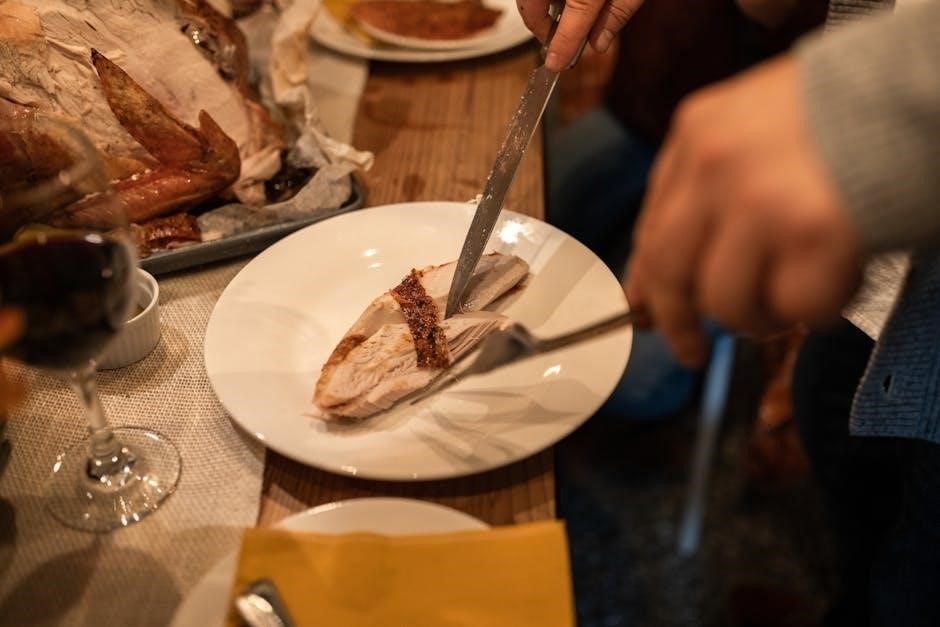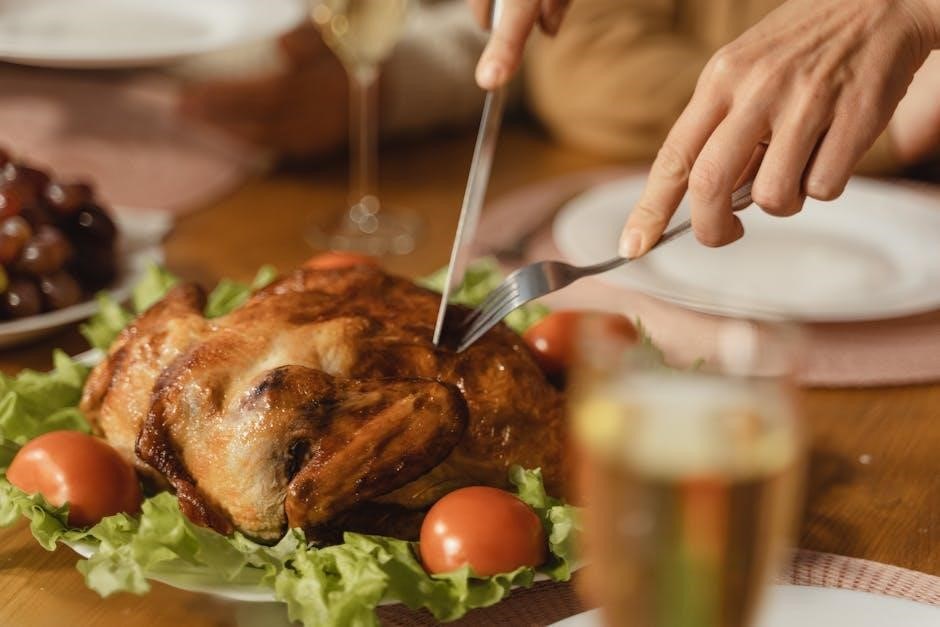Meat slicing is a fundamental culinary skill that enhances both the visual appeal and flavor of dishes. Proper techniques ensure consistent, even cuts, elevating any meal.
1.1 Importance of Proper Meat Slicing
Proper meat slicing ensures uniform thickness, which is crucial for even cooking and tenderness. It enhances flavor distribution and presentation, making dishes more visually appealing. Slicing against the grain also improves texture, reducing chewiness. Mastering this skill elevates the dining experience and showcases culinary expertise, making it a fundamental technique for home cooks and professionals alike.
1.2 Brief Overview of Meat Slicing Techniques
Meat slicing techniques vary from basic to advanced methods. Fundamental techniques include slicing against the grain for tenderness and portioning for consistency. Advanced methods involve julienne cuts for delicate dishes and precise dicing for uniformity. Each technique requires the right tools, like sharp knives, and practices like chilling meat for easier handling. Mastery of these techniques ensures professional-quality results in every dish.

Tools and Equipment for Meat Slicing
The right tools are essential for precise meat slicing. A sharp, high-quality knife is vital, while meat slicers offer uniformity. Cutting boards and gloves enhance safety and efficiency.
2.1 Choosing the Right Knife for Meat Slicing
Selecting the right knife is crucial for efficient meat slicing. A sharp, high-carbon steel blade is ideal, offering precision and durability. For raw meat, a straight-edge knife works best, while serrated knives excel with cooked or fatty meats. Ensure the knife fits comfortably in your hand for better control and safety during slicing tasks.
2.2 Maintaining Knife Sharpness
A sharp knife is essential for clean, precise slices. Regular sharpening prevents tearing the meat and ensures safety. Use a whetstone or sharpening steel to maintain the edge, honing before each use. Dull knives require more force, increasing the risk of accidents. Proper maintenance extends the knife’s lifespan and enhances slicing efficiency, making every cut effortless and accurate.

Understanding Meat Structure
Understanding meat structure is crucial for effective slicing. The grain, muscle fibers, and connective tissue determine tenderness and texture. Identifying these elements ensures precise cuts and optimal results.
3.1 Identifying the Grain of the Meat
Identifying the grain of the meat is essential for achieving tender slices. The grain refers to the direction of muscle fibers, which can be seen as lines or striations. Cutting against the grain ensures a more tender and less chewy texture, while cutting with the grain can result in tougher, less palatable meat. Proper grain identification enhances both flavor and texture.
3.2 Muscle Structure and Its Impact on Slicing
The muscle structure of meat significantly impacts slicing outcomes. Muscles consist of fibers and connective tissue, which determine tenderness. Slicing parallel to muscle fibers results in chewier meat, while cutting against them yields tender slices. Understanding muscle alignment ensures even cuts and optimal texture, making it a critical factor in achieving professional-grade meat slicing results consistently.
Basic Cutting Techniques
Mastering foundational cutting techniques is essential for precise meat slicing. These methods form the basis for more complex cuts, ensuring uniformity and quality in every slice.
4.1 Slicing Against the Grain
Slicing against the grain involves cutting perpendicular to the meat’s muscle fibers, ensuring tenderness and ease of chewing. Identify the grain direction by inspecting the meat’s lines. Use a sharp knife to make smooth, even cuts across these lines. This technique prevents chewy textures and enhances the meat’s natural flavor, resulting in more enjoyable and visually appealing dishes.
4.2 Portioning and Trimming
Portioning involves cutting meat into consistent sizes for uniform cooking and presentation. Trimming removes excess fat, connective tissue, or unwanted edges, enhancing texture and appearance. Both steps require precise knife work and attention to detail. Proper portioning and trimming ensure meals are visually appealing and evenly cooked, making them more enjoyable and professional-looking. A sharp knife is essential for clean, accurate cuts.
Advanced Slicing Techniques
Advanced slicing techniques elevate dishes with precision and artistry. Methods like julienne, dicing, and thin slicing require skill and practice for professional results, enhancing flavor and presentation.
5.1 Julienne and Dicing
Julienne and dicing are advanced techniques that involve cutting meat into precise, uniform strips or cubes. Julienne strips are typically 1/8 inch thick and 2-3 inches long, while dicing creates 1/2 inch cubes. These methods ensure even cooking and a polished presentation, perfect for dishes like stir-fries or salads. Mastery requires a sharp knife and consistent slicing motion.
5.2 Slicing Thinly for Delicate Dishes
Slicing meat thinly is crucial for delicate dishes like sashimi or carpaccio, where texture and presentation are key. To achieve paper-thin slices, use a sharp knife and slice against the grain. Partially freezing the meat can firm it up, making precise cuts easier. This technique ensures maximum tenderness and enhances the overall dining experience.
Slicing Different Types of Meat
Different meats require tailored slicing techniques to optimize flavor and texture. Understanding each type, from raw to cooked and delicate options like fish, ensures ideal results.
Slicing raw meat requires precision and care to maintain quality. Chilling or partially freezing ensures cleaner cuts. Use a sharp knife, cut against the grain for tenderness, and achieve uniform slices. This technique enhances texture and flavor, making it ideal for dishes like stir-fries or sashimi. Proper handling prevents damage and ensures safety. Slicing cooked meat requires a steady hand and sharp knife. Allow meat to rest before slicing to retain juices. Cut against the grain for tenderness, especially for roasts or poultry. Thin, uniform slices are ideal for presentations and dishes like sandwiches or buffets. Proper technique ensures even portions and enhances the overall dining experience. Patience is key for perfect results. Slicing delicate meats like fish and poultry requires precision and care. Always chill the meat slightly to firm it up, making it easier to handle. Use a sharp, thin knife to avoid tearing. Cut gently against the grain for even, tender slices. For fish, a fillet knife works best, while poultry benefits from a serrated edge. Presentation and texture are enhanced with clean, smooth cuts. Always use a sharp knife for better control. Cut on a stable surface. Keep fingers away from the blade. Store knives safely when not in use. Handling knives safely is crucial to prevent injuries; Always use a sharp knife, as it provides better control and reduces accidents. Grip the knife firmly, with a secure hold, and keep fingers tucked away from the blade. Cut on a stable surface, maintaining focus, and avoid loose clothing that could obstruct your view. Store knives safely when not in use. Preventing accidents while slicing requires attention to detail and proper preparation. Always ensure the meat is secure on the cutting board to avoid slippage. Keep your eyes focused on the blade and maintain a steady hand. Use a sharp knife, as a dull blade is more likely to cause unintended cuts. Never apply excessive force, which can lead to loss of control. Chilling or freezing meat enhances firmness, allowing cleaner cuts and minimizing tearing. This step ensures precise slicing and helps achieve uniform thickness for consistent results. Chilling meat before slicing firms its texture, making it easier to handle and slice cleanly. Refrigerate for 30 minutes to an hour to enhance precision and prevent tearing. This step ensures even cuts and maintains the meat’s integrity, especially for delicate or fatty meats; Chilling is a simple yet effective way to achieve professional-quality slices. Freezing meat for 30 minutes firms it slightly, making it easier to slice thinly and evenly. This technique is especially useful for delicate meats like fish or poultry. Partial freezing reduces moisture loss and prevents tearing, ensuring clean cuts. Use a sharp knife and slice against the grain for the best results. Perfect for achieving uniform, professional-quality slices. Uniform slicing ensures even cooking and a polished presentation. It prevents uneven thickness, promoting consistent texture and flavor. Use sharp tools and a steady hand for precise, professional results. Achieving even thickness in meat slicing is crucial for consistent cooking. Use a sharp knife, cut against the grain, and employ a steady rocking motion; Chilling or lightly freezing the meat firms it, making uniform slices easier. This technique ensures each slice cooks evenly, enhancing texture and flavor in every dish. Uniform slices ensure consistent cooking, preventing undercooked or overcooked areas. They enhance visual appeal, making dishes look professional and appetizing. Evenly sized pieces also improve texture and flavor distribution, ensuring every bite is satisfying. Uniformity is key for achieving a polished presentation in both home and professional settings, elevating the overall dining experience. Specialized tools like meat slicers and sharp knives ensure precision and efficiency. Cutting boards provide stability, making slicing safer and more accurate for all meat types. Meat slicers are essential tools for achieving uniform, precise cuts. They are designed to handle various meats, from raw to cooked, ensuring consistent thickness and ease of use. Whether for deli-style slices or thin cuts for stir-fries, meat slicers enhance efficiency and accuracy, making them a valuable asset for both home cooks and professionals. Cutting boards are crucial for maintaining hygiene and preventing cross-contamination during meat slicing. They offer a stable surface that protects both the knife and countertop, ensuring safer and more accurate cuts. Choosing the right material, such as wood or plastic, can enhance durability and ease of cleaning, making them essential tools in any kitchen. Cutting boards are essential for maintaining hygiene and preventing cross-contamination during meat slicing. They provide a stable surface for precise cuts, protecting both the knife and countertop. Choosing the right material, such as wood or plastic, enhances durability and ease of cleaning, ensuring a safe and efficient slicing process. The rocking motion is a key technique for achieving smooth, even slices. By gently moving the knife back and forth while applying consistent pressure, you can glide through the meat effortlessly. This method ensures precision and control, making it easier to maintain uniform thickness. For optimal results, keep the blade sharp and the meat firm. A dull knife can tear the meat, while a sharp one glides cleanly, producing perfect slices every time. Slicing at the right angle is crucial for achieving uniform, visually appealing cuts. Hold the knife at a 45-degree angle to ensure slices are even and consistent. This technique prevents tearing and helps maintain the meat’s texture, making dishes look professional and taste exceptional. Mastering meat slicing enhances flavor, texture, and presentation. With practice, you’ll achieve consistency, creating dishes that impress. Keep refining your skills for exceptional results every time. Effective slicing involves cutting against the grain for tenderness, using sharp tools, and maintaining consistent thickness. Techniques like julienne and dicing add versatility, while chilling or freezing meat ensures easier handling. Safety, precision, and understanding meat structure are crucial for achieving professional results. These methods collectively enhance both the quality and presentation of your dishes. To master meat slicing, practice patience and precision. Always use sharp knives and maintain proper cutting angles. Chilling meat before slicing ensures clean cuts, while understanding grain directions enhances tenderness. Consistent practice and attention to detail will refine your skills, leading to perfectly sliced meats every time, whether for professional dishes or home-cooked meals.6.1 Raw Meat Slicing
6.2 Cooked Meat Slicing
6.3 Slicing Delicate Meats (Fish, Poultry)

Safety Tips for Meat Slicing
7.1 Handling Knives Safely
7.2 Preventing Accidents While Slicing
Chilling and Freezing for Better Slicing
8.1 Chilling Meat Before Slicing
8.2 Freezing Techniques for Easier Slicing

Uniform Slicing for Consistency
9.1 Achieving Even Thickness
9.2 Importance of Uniform Slices
Specialized Slicing Tools
10.1 Meat Slicers and Their Uses
Expert Tips for Perfect Slices
10.2 Cutting Boards and Their Role
11.1 Mastering the Rocking Motion
11.2 Slicing at the Right Angle
12.1 Recap of Key Slicing Techniques
12.2 Final Tips for Mastery